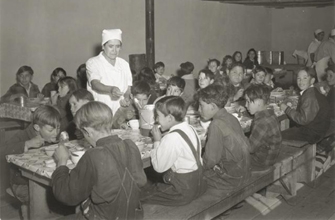
Having a lunch lady be the featured speaker at an eighth-grade promotion might raise the eyebrows of some, but for this school and this school district, it makes sense. Cabrillo is part of the Ventura Unified School District, which operates farm-to-school salad bar programs at 17 campuses, and has gained national attention as an early adopter of farm-to-school and innovative nutrition programs. The farm-to-school program is part of the larger Healthy Schools Program, which also provides nutrition education and support for school gardens.
The choice of Rita Pisani as the person to deliver the parting words of wisdom to teens embarking on their high school journey also made a lot of sense in terms of a national context. With a White House supporting good food, gardening and obesity prevention initiatives, with the USDA sponsoring its People’s Garden Initiative, with farm-to-school and other good food advocates challenging the status quo with the school lunch program, it makes sense that someone like Mrs. Pisani – who has dedicated her life to feeding people, especially kids – should be heard. Food, after all – especially good food – is central to the health and well being of our youth and central to our success and security as a nation in the future.
Mrs. Pisani told a compelling story about a young girl. Born in wartime Italy, this girl’s hearing was severely damaged by bombing raids that occurred when she was very young. (The girl’s hearing loss was not fully diagnosed until she was 25; it was determined to be 80 percent in both ears, and she had surgery and was given hearing aids). Knowing that being “different” might result in limited opportunities for her daughter, the girl’s mother taught her how to read lips, analyze facial and eye expressions, and study gestures. As an eighth-grader the girl immigrated to the United States and was immersed in English-only classes, even though she spoke only Italian. A dedicated teacher spent two hours a day helping the girl learn English. The surprise ending? That girl was Rita Pisani, the lunch lady.
Mrs. Pisani shared her belief that this is exactly the time in life when these young people will have to make decisions, particularly about the kind of people they will be. And they are of an age where they will have to live with their choices. (And one choice she strongly encouraged them to make? Don’t cut in line!).
Some of the most important choices will center on how these teens choose to care for and nourish their bodies. As citizens and taxpayers, it’s in our best interest to make sure that good food choices in public schools are the norm, not the exception.
Lawmakers are taking action on the issue of childhood nutrition. Before its August recess, the Senate passed S3307 (the Healthy, Hunger-Free Kids Act), which would invest $4.5 billion into child nutrition. The clincher? It offset the proposed increase to childhood nutrition programs by suggesting a $2.2 billion reduction in the SNAP (formerly Food Stamps) program, where need is growing due to the nation’s dire economic situation. Over the summer, the House Education and Labor Committee passed HR 5504 (Improving Nutrition for America’s Children Act), which would invest $8 billion in childhood nutrition; however, the bill is stalled, because funds to pay for this have not been located.
The Childhood Nutrition Reauthorization Act, a major omnibus bill, includes numerous components, and is also stalled in Congress. It is renewed on a five-year cycle; Congress should have renewed it in 2009, but the national dialog about health care delayed discussion and passage. The bill has been extended until Sept. 30, 2010. It encompasses the National School Lunch Program; the School Breakfast Program; the Child and Adult Care Food Program; the Summer Food Service Program; Women, Infants and Children (WIC), including, the WIC Farmers’ Market Nutrition Program; the Fresh Fruit and Vegetable Program; and the Special Milk Program. Because the Act is so large and comprehensive, it’s important for citizens to learn more about it and its components. Information is available at www.schoolnutrition.org/Content.aspx?id=2402
All of the legislation described above affects children and lunch ladies across the nation, lunch ladies like Mrs. Pisani. I have considered Mrs. Pisani’s words over and over the last few months. As she concluded her remarks, she told Cabrillo students, “I love to cook for people and serve them food. This is my passion. I have done it as a head chef, restaurant owner and caterer most of my life. This is why now I am happy to be your lunch lady.” Cabrillo’s principal, Glory Page, made an important observation about Mrs. Pisani: “She serves food, but more importantly, she serves kids.”
Lunch ladies do serve kids, in all sorts of ways. I loved my lunch lady, Mrs. Ketchell, who helped us work through challenges and life problems by engaging us to work alongside her in the cafeteria at Joshua Elementary School. The privilege of working in the cafeteria was reserved for older students. We couldn’t wait for our week to help prepare and serve food, and clean the cafeteria after lunch. It connected us to caring adults, it instilled in us a work ethic, it honored the collaborative and community nature of food preparation and eating, it enabled us to serve other students and it connected us to our food.
